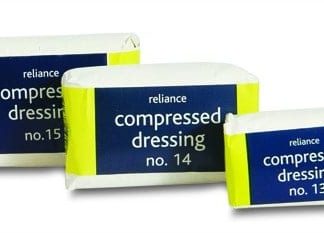Description
Compressed Dressings
Also known as ‘mines’ dressings, because of their long association of use in the mining industry, Compressed Dressings are intended to provide a thick absorbent sterile pad while taking up as little room as possible.
Compressed and packaged into a compact wrapping, these dressings may look small but are still up to the job of dealing with moderate injuries.
Development of compressed bandages.
Bandages have a history stretching back thousands of years to the time of the ancient Egyptians, who used simple woven fabrics, often coated with adhesives, resins and other medicaments as dressings to aid wound healing. Like some of the bandages used today, these were made from non-extensible fabric and probably required considerable skill on the part of the user to ensure correct application.
In the 17th century, Pierre Dionis who was Surgeon-in-Ordinary to the queen of France and to the Empress Maria Theresa of Austria, recommended the use of rigid lace-up stockings made from coarse linen or dog skin to apply compression in the treatment of leg ulcers: the bandages available at that time were not suitable for the application of sustained, controlled compression because of their inelastic nature. It was not until the middle of the 19th century that the first elasticated bandages, containing natural rubber, were manufactured. In 1878, Callender published a letter in the Lancet which described the use of these materials in the management of varicose veins.
In the United Kingdom, standards for bandages first appeared in a supplement to the 1911 British Pharmaceutical Codex (BPC). The Codex included a specification for an extensible Crepe bandage (containing cotton and wool yarns), as well as monographs for simple non-extensible products such as calico, flannel, domette and open wove bandages. These bandages had a simple retention function, although they also provided warmth and protection. As new products were developed, additional monographs were introduced, but when the publication of the Codex ceased, many of these standards were transferred into the British Pharmacopoeia. Despite differences in the structure and composition of these early bandages, the majority were produced from natural fibres by a weaving process and in this respect, they were essentially similar to the linen materials used by the ancient Egyptians thousands of years earlier.
Do You Have a Question about This Product – Ask Wessex







Reviews
There are no reviews yet.